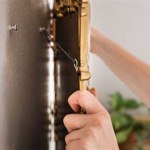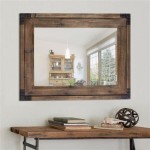Hanging a Mirror on a Wall: A Comprehensive Guide
A mirror is a functional and decorative element in interior design. Mirrors enhance the perception of space, reflect light to brighten rooms, and serve as a focal point. However, the process of hanging a mirror securely and aesthetically can be challenging depending on the mirror’s size, weight, and the wall material. This article provides a detailed guide on how to hang a mirror on a wall, covering preparation, tool selection, safety considerations, and installation techniques.
1. Preparation and Planning
Before beginning the installation process, meticulous preparation is crucial. This stage involves selecting the appropriate location for the mirror, gathering necessary tools and materials, and assessing the wall's structural integrity.
Selecting the Location: The intended location for the mirror should be carefully considered. Factors to contemplate include the room's lighting, the desired focal point, and the mirror's intended function. For example, a full-length mirror is typically placed in a bedroom or dressing area, while a smaller decorative mirror may be suitable for a hallway or living room. Avoid placing mirrors where they directly reflect clutter or undesirable views. Consider the height at which the mirror will be hung. Eye-level is generally recommended for functional mirrors, while decorative mirrors can be hung higher or lower based on aesthetic preferences.
Gathering Tools and Materials: The required tools and materials depend on the mirror’s weight and the wall type. Essential tools include a measuring tape, a level, a pencil, a drill with appropriate drill bits, a stud finder (if applicable), and a screwdriver. Fasteners, such as screws, anchors, or hanging hardware specifically designed for mirrors, are necessary for securely attaching the mirror to the wall. The type of fastener should be appropriate for the wall material (e.g., drywall, plaster, wood, or concrete). Painter's tape can be used to mark the mirror's position and protect the wall from scratches.
Assessing Wall Structure: The type of wall determines the appropriate hanging method. Drywall is a common wall material, but it requires the use of anchors to support heavier mirrors. Studs are vertical wooden or metal framing members within the wall that provide significantly greater support. A stud finder can locate these studs. Plaster walls may require specialized drilling techniques to prevent cracking. Concrete or brick walls necessitate the use of masonry drill bits and anchors. Understanding the wall's structure is paramount for a secure and lasting installation. Attempting to hang a heavy mirror solely on drywall without anchors is likely to result in failure.
2. Selecting Appropriate Hanging Hardware
The choice of hanging hardware is a critical determinant of the mirror's stability and safety. Selecting the correct hardware involves evaluating the mirror's weight, the wall type, and the desired mounting method. Incorrect hardware poses a risk of the mirror falling, causing damage to the mirror, the wall, and potentially causing injury.
Weight Capacity: All hanging hardware is rated for a specific weight capacity. Exceeding this weight capacity can lead to failure. Determine the precise weight of the mirror using a scale if necessary. Select hardware with a weight rating that significantly exceeds the mirror's weight to provide a safety margin. For example, if a mirror weighs 20 pounds, choose hardware rated for at least 30 pounds.
Types of Hanging Hardware: Various types of hanging hardware are available, each designed for specific applications: * D-rings and Wire: This is a common method for hanging lighter mirrors. D-rings are attached to the back of the mirror frame, and a wire is threaded through them. The wire is then hung on a hook or nail in the wall. This method is suitable for mirrors weighing up to 10 pounds. * Screws and Anchors: This is a versatile method for hanging mirrors on drywall. Anchors provide support in the drywall, allowing screws to be securely fastened. Different types of anchors are available, including drywall anchors, toggle bolts, and self-drilling anchors. Toggle bolts are particularly strong and are suitable for heavier mirrors. * French Cleats: This method involves two interlocking pieces of wood or metal. One piece is attached to the wall, and the other is attached to the back of the mirror. The mirror is then hung by sliding the two pieces together. French cleats provide a secure and level hanging solution, particularly suitable for larger and heavier mirrors. * Mirror Clips: These are small metal or plastic clips that are screwed into the wall to hold the mirror in place. Mirror clips are typically used for frameless mirrors.
Wall Type Considerations: The type of wall influences the choice of hanging hardware. For drywall, anchors are essential. For wood studs, screws can be directly driven into the studs without anchors. For concrete or brick walls, masonry anchors are required. Selecting hardware that is compatible with the wall type is critical for a secure installation. Using drywall anchors in a concrete wall, for instance, will not provide adequate support.
3. Installation Techniques: Step-by-Step Guide
The installation process requires precision and attention to detail. Following a systematic approach ensures a secure and aesthetically pleasing result.
Marking the Location: Use a measuring tape and level to determine the precise location for the mirror. Mark the top and bottom edges of the mirror on the wall using a pencil. Use painter's tape to outline the area where the mirror will be hung. This protects the wall and provides a clear visual guide.
Locating Studs (If Applicable): Use a stud finder to locate studs within the wall. Mark the location of the studs with a pencil. If possible, aim to attach the mirror directly to the studs, as this provides the strongest support. If studs are not available at the desired location, anchors will be necessary.
Drilling Pilot Holes: If using screws and anchors, drill pilot holes at the marked locations. The diameter of the pilot hole should be slightly smaller than the diameter of the screw or anchor. For drywall, use a drill bit specifically designed for drywall. For concrete or brick, use a masonry drill bit. When drilling, apply consistent pressure and keep the drill level.
Installing Anchors: Insert the anchors into the pilot holes. Different types of anchors have different installation procedures. Some anchors are hammered into place, while others are screwed in. Follow the manufacturer's instructions for installing the specific type of anchor being used. Ensure that the anchors are flush with the wall surface.
Attaching the Mirror: Align the mirror with the marked location on the wall. If using D-rings and wire, hang the wire on the hooks or nails that have been installed in the wall. If using screws and anchors, insert the screws through the mirror's mounting hardware and into the anchors. Tighten the screws until the mirror is securely attached to the wall. Avoid over-tightening the screws, as this can damage the mirror or the wall.
Using Mirror Clips: For frameless mirrors using mirror clips, position the bottom clips first, ensuring they are level. Place the mirror on the bottom clips and then install the top and side clips to secure the mirror. Ensure uniform spacing between the clips and the mirror's edge.
4. Safety Considerations
Safety should be a primary concern throughout the installation process. Taking precautions minimizes the risk of injury and damage. Safe handling of the mirror, proper use of tools, and attention to the surrounding environment are crucial.
Handling the Mirror: Mirrors can be heavy and fragile. Always handle the mirror with care to avoid breakage. Wear gloves to protect hands from sharp edges. If the mirror is large or heavy, enlist the help of another person to lift and position it. Avoid placing the mirror on hard surfaces that could scratch or damage the glass.
Using Tools Safely: Use power tools, such as drills and screwdrivers, according to the manufacturer's instructions. Wear safety glasses to protect eyes from debris. Ensure that the work area is well-lit and free of obstructions. Keep the power cords of tools away from water and other potential hazards. If unsure about using a particular tool, consult a professional.
Wall Integrity: Before drilling into the wall, be aware of the location of electrical wiring and plumbing. Drilling into electrical wires or water pipes can be hazardous and costly to repair. Use a wire and pipe locator to detect any hidden utilities. If unsure about the location of utilities, consult a professional electrician or plumber.
Personal Protective Equipment: Using personal protective equipment (PPE) such as safety glasses and gloves is advisable to prevent injury. Eye protection is especially important when drilling, as small particles of drywall, plaster, or concrete can be ejected from the drill site. Gloves provide a better grip and help prevent cuts from sharp edges on the mirror or hardware.
By carefully considering the location, selecting appropriate hardware, following a step-by-step installation process, and prioritizing safety, hanging a mirror on a wall can be accomplished successfully and safely. The end result will be a functional and aesthetically pleasing addition to the space.

Hanging Mirror Over The Door Neutypechic

Do S And Don Ts For Hanging Your Mirrors Artwork The Seattle Times

Objects Of Design 341 Round Hanging Mirror Mad About The House

Modern Leather Round Hanging Mirror 36 West Elm

Decor Wall Hanging Mirror Black Gold Round Mounted Circle Metal With Chain For Home Bathroom Bedroom Living Room China Made In Com

Hanging Up Mirror Wall Ideas Lou Style

Xramfy 24 In W X H Round Mirror With Hanging Leather Strap Aluminum Frame Black Wall Rmls24 The Home Depot

Round Hanging Chain Wall Mirror 45cm Black Dunelm

Hanging Mirror With Rope For Modern Contemporary Decor Mohh

Motini Round Hanging Mirror Circle 26 Inch Gold Brushed Brass Stainless Steel Metal Frame With Chain And Hook Wall Mounted Vanity For Ba








